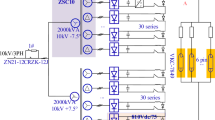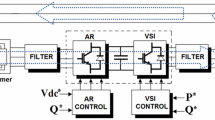Abstract
As the calculation of transformer no-load characteristics measured by low-frequency test method is not perfect, different interpolation methods are explored to fit and convert the transformer's volt-ampere characteristics under power frequency (50 Hz) excitation to find the best interpolation fitting conversion method. The no-load test of transformer is carried out by using 10 Hz, 15 Hz, 20 Hz low-frequency square wave and triangular wave excitation. Then the measured excitation voltage, excitation current and no-load loss are converted to those of 50 Hz sine wave excitation. The converted volt-ampere characteristic curve is calculated by the proposed algorithm, and compared with the measured results under the 50 Hz sine wave excitation. Experiments show that under the condition that the magnetic flux amplitudes are equal at each frequency of non-sinusoidal and sine waves, whether it is square wave or triangular wave excitation, the volt-ampere characteristic curve converted to the 50 Hz sine wave excitation by the proposed method can better approximate the curve of the measured 50 Hz sine wave excitation. The average values of the relative errors of the converted excitation current of the three frequencies are within 4%, and those of the converted excitation voltage of the square wave are within 1.1%, and those of the converted excitation voltage of the triangular wave are within 0.47%. Compared with the generalized Steinmetz equation method and the multi-frequency method, the proposed method has a better conversion effect and can almost replace the no-load test results of the 50 Hz sine wave, which has practical value in engineering.









Similar content being viewed by others
References
Gaudreau A, Picher P, Bolduc L et al (2002) No-load losses in transformer under overexcitation/inrush-current conditions: tests and a new model. IEEE Trans Power Deliv 17(4):1009–1017
Olivares JC, Liu Y, Cañedo JM et al (2003) Reducing losses in distribution transformers. IEEE Trans Power Deliv 18(3):821–826
Yazdani-Asrami M, Mirzaie M, Akmal AAS (2013) No-load loss calculation of distribution transformers supplied by nonsinusoidal voltage using three-dimensional finite element analysis. Energy 50:205–219
Asadi N, Kelk HM (2015) Modeling, analysis, and detection of internal winding faults in power transformers. IEEE Trans Power Deliv 30(6):2419–2426
(2000) Power Transformers-Part 1: general, IEC Std. 60076-1 (2000-04)
Ionel DM, Popescu M, Dellinger SJ et al (2006) On the variation with flux and frequency of the core loss coefficients in electrical machines. IEEE Trans Ind Appl 42(3):658–667
Zirka SE, Moroz YI, Marketos P et al (2004) Dynamic hysteresis modelling. Phys B Cond Matter 343(1–4):90–95
Krings A, Soulard J (2010) Overview and comparison of iron loss models for electrical machines. J Elect Eng 10(3):162–169
Novak G, Kokošar J, Bricelj M et al (2017) Improved model based on the modified Steinmetz equation for predicting the magnetic losses in non-oriented electrical steels that is valid for elevated temperatures and frequencies. IEEE Trans Magn 53(10):1–5
Ayachit A, Kazimierczuk MK (2016) Steinmetz equation for gapped magnetic cores. IEEE Magn Lett 7:1–4
Barg S, Ammous K, Mejbri H et al (2017) An improved empirical formulation for magnetic core losses estimation under nonsinusoidal induction. IEEE Trans Power Elect 32(3):2146–2154
Yue S, Li Y, Yang Q et al (2018) Comparative analysis of core loss calculation methods for magnetic materials under nonsinusoidal excitations. IEEE Trans Magn 54(11):1–5
Jafari M, Malekjamshidi Z, Lei G et al (2016) Design and implementation of an amorphous high-frequency transformer coupling multiple converters in a smart microgrid. IEEE Trans Ind Elect 64(2):1028–1037
Steinmetz CP (1984) On the law of hysteresis. Trans Am Inst Elect Eng 72(2):197–221
Bertotti G (1988) General properties of power loss in soft ferromagnetic materials. IEEE Trans Magn 24(1):621–630
Popescu M, Ionel DM (2007) A best-fit model of power losses in cold rolled motor lamination steel operating in a wide range of frequency and magnetization. IEEE Trans Magn 43(4):1753–1756
Ibrahim M, Pillay P (2012) Advanced testing and modeling of magnetic materials including a new method of core loss separation for electrical machines. IEEE Trans Ind Appl 48(5):1507–1515
(2008) Test guide for instrument transformers-part 1: current transformers, China Std. GB/T 22071.1 (2008-06).
Li Q, Wang X (1997) Research on fitting methods of core excitation characteristics of transformer. High Volt Eng 23(1):19–21
Liang S, Wen H, Zhao J et al (2010) A compensation calculation method for measuring ferromagnetic component volt-ampere characteristic using low frequency and frequency conversion power. Proc CSEE 30(3):125–129
Liu X, Yao C, Liang S et al (2017) Measurement of the no-load characteristics of single-phase transformer using an improved low-frequency method. IEEE Trans Ind Elect 65(5):4347–4356
Yao C, Liu X, Hu D, Wan J, Wang J (2017) No-load current harmonics measurement of transformers using low-frequency method. Trans China Electrotech Soc 32(22):115–122
Parsapour A, Dehkordi BM, Moallem M (2015) Predicting core losses and efficiency of SRM in continuous current mode of operation using improved analytical technique. J Magn Magn Mater 378:118–127
Ionita V, Petrescu L, Cazacu E (2018) Improved estimation of iron losses for non-sinusoidal voltages. COMPEL Int J Comput Math Elect Elect Eng 37(5):1698–1706
Hussain S, Lowther D (2016) The prediction of iron losses under PWM excitation using the classical Preisach model. COMPEL Int J Comput Math Elect Elect Eng 35(6):1996–2006
Roshen WA (2007) A practical, accurate and very general core loss model for nonsinusoidal waveforms. IEEE Trans Power Elect 22(1):30–40
Zhang N, Li L, Wei X (2016) Calculation method and experimental verification of core losses under non-sinusoidal excitation. Trans China Electrotech Soc 31(17):224–232
(2018) IEEE recommended practice for establishing liquid-immersed and dry-type power and distribution transformer capability when supplying nonsinusoidal load currents, IEEE Std C57.110-2018 (Revision of IEEE Std C57.110-2008)
Hatakeyama T, Onda K (2014) Core loss estimation of various materials magnetized with the symmetrical/asymmetrical rectangular voltage. IEEE Trans Power Elect 29(12):6628–6635
Guerra FCF, Mota WS (2007) Magnetic core model. IET Sci Measur Technol 1(3):145–151
Hurley WG, Wölfle WH (2013) Transformers and inductors for power electronics: theory, design and applications. Wiley, Hoboken, pp 109–112
Fiorillo F, Novikov A (1990) An improved approach to power losses in magnetic laminations under nonsinusoidal induction waveform. IEEE Trans Magn 26(5):2904–2910
Novak G, Kokošar J, Nagode A et al (2015) Core-loss prediction for non-oriented electrical steels based on the Steinmetz equation using fixed coefficients with a wide frequency range of validity. IEEE Trans Magn 51(4):1–7
Roshen W (1991) Ferrite core loss for power magnetic components design. IEEE Trans Magn 27(6):4407–4415
Li J, Abdallah T, Sullivan CR et al (2001) Improved calculation of core loss with nonsinusoidal waveforms. IEEE Ind Appl Soc Ann Meet 4:2203–2210
Acknowledgements
This work is supported by National Natural Science Foundation of China (51477015), the Visiting Scholarship of State Key Laboratory of Power Transmission Equipment & System Security and New Technology (Chongqing University) (2007DA10512714406), the Natural Science Foundation of Fujian Province of China (2018J01511) and the Program for New Century Excellent Talents in Fujian Province University (2018047).
Author information
Authors and Affiliations
Corresponding author
Additional information
Publisher's Note
Springer Nature remains neutral with regard to jurisdictional claims in published maps and institutional affiliations.
Appendices
Appendix A
For sine wave excitation, it is assumed that the induced electromotive force at both ends of the core is:
where Em is the peak value of electromotive force.
From formula (1), the magnetic flux density B(t) is:
In formulas (A2) and (A3), Bm is the magnitude of the magnetic flux density, and E is the effective value of the electromotive force.
Similarly, for square wave excitation, it is assumed that the induced electromotive force and magnetic flux density at both ends of the core are:
From equations (A3) and (A6), it can be seen that to keep the amplitude of the magnetic flux density Bm generated by the excitation voltages of square wave and sine wave at the same frequency equal, and it is necessary to make:
where Esin is the effective value of sine wave, and Esqu is the effective value of square wave.
Similarly, for triangular wave excitation, it is assumed that the induced electromotive force and magnetic flux density at both ends of the core are:
It can be seen from formulas (A3) and (A10) that to keep the amplitude of the magnetic flux density Bm generated by the excitation voltages of triangular wave and sine wave at the same frequency equal, and it is necessary to make:
where Esin is the effective value of sine wave, and Etri is the effective value of triangular wave.
For the transformer, ignoring the voltages of the leakage inductance and DC resistance, so that the effective value of the sine wave excitation voltage is 1.11 times that of the square wave, then the amplitude of magnetic flux density Bm generated under the two waveform excitations can be equal. This is also the basis of the volt-ampere characteristic curve and core loss under square wave excitation that can be converted to a sine wave. At the same time, it can be known from Eqs. (5) and (8) that, for voltage excitations at different frequencies of the same waveform, as long as the ratio of the effective value of the applied voltage is equal to the ratio of the frequencies, the generated Bm is equal.
Appendix B
In reference [33], the core loss was calculated and derived, and the equivalent formula for eddy current loss was obtained:
where N is the number of turns, A is the area of the cross section and ρ is the resistivity of the core material.
Considering the effective value of electromotive force:
Combining equations (B1) and (B2), it can be concluded that:
Combining equations (A3) and (B3), the eddy current loss Pe-sin under sine wave excitation can be obtained as follows:
Combining equations (A6) and (B3), it can be concluded that the eddy current loss under square wave excitation Pe-squ is:
According to formulas (A10) and (B3), the eddy current loss Pe-tri under triangular wave excitation is as follows:
From equations (B4), (B5) and (B6), it can be seen that the eddy current loss is still proportional to the square of Bm and f, no matter for sine wave, square wave or triangular wave excitation, only the difference of proportion coefficient.
Appendix C
Rights and permissions
About this article
Cite this article
Chen, X., Yang, N. & Yang, Y. Comparison of low-frequency non-sinusoidal measurement for transformer no-load characteristics based on different interpolation methods. Electr Eng 103, 1807–1821 (2021). https://doi.org/10.1007/s00202-020-01199-w
Received:
Accepted:
Published:
Issue Date:
DOI: https://doi.org/10.1007/s00202-020-01199-w




